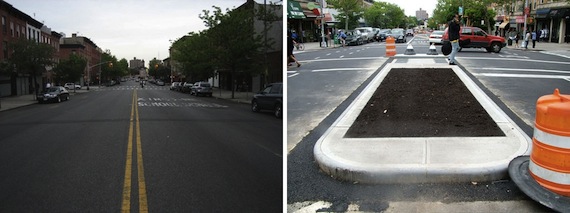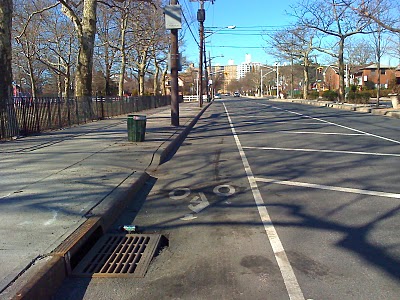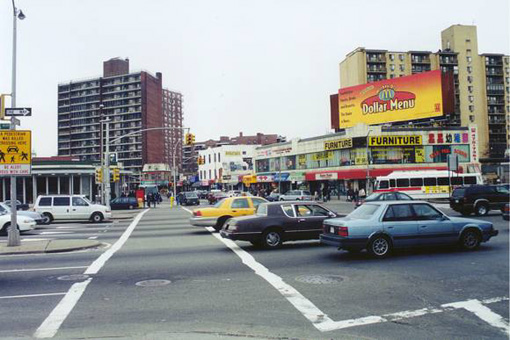
When faced with the question of how to fix a dangerous street, the first instinct of many New Yorkers is to call for the most familiar symbols of regulating cars: the stop sign and the traffic light. Nothing, they think, could more effectively force dangerous drivers to stop speeding through their neighborhood than these familiar red symbols. Just this month a community group in Manhattan Beach, Brooklyn asked the city to remove a bike lane and zebra stripes from Oriental Boulevard -- measures that have a real traffic-calming effect -- and add a new traffic signal where the road intersects with Falmouth Street. But stop signs and traffic signals are usually ineffective, even counterproductive, if the goal is to make streets safer.
Sometimes, the demand for traffic control devices is driven by good intentions, as when City Council Member Karen Koslowitz urged the city last year to stop treating Queens Boulevard "like it's a highway" and instead make it a "pedestrian-crossing street." Koslowitz was calling for a new traffic light at the intersection of Queens Boulevard and 80th Road.

Other times, it's part of an attack on more effective traffic calming measures. During Dov Hikind's epic tirade against NYC DOT at a Brooklyn Community Board 12 hearing last December, the assembly member contrasted the construction of pedestrian refuges on Fort Hamilton Parkway with his long campaign to get a traffic light installed elsewhere in his district. "You know, because you live there, you know how dangerous that corner is. I had a situation on East 4th and M, where people died, and the Department of Transportation turned down the traffic device four times," said Hikind. Eventually he prevailed and a traffic light was installed at the location.
These fights -- which local politicians apparently relish -- can last years. Together, Peter Vallone Sr. and Jr. fought for a traffic signal at 21st Street and 30th Drive in Astoria for 41 years before a light was installed in 2008. Requests for stop signs or traffic lights are so common that the City Council recently passed a law requiring DOT to explain to community boards and Council members why it rejects them.
Each case is different, but in the aggregate, the reason traffic control devices aren't installed more frequently is quite simple: They tend to make streets less safe, not more.
Reid Ewing, a professor at the University of Utah, literally wrote the book on traffic calming -- the Institute of Transportation Engineers' Traffic Calming: State of the Practice. "They're good for traffic control," said Ewing of stop signs and traffic lights. "They're not so good for traffic calming." In other words, they help make traffic flow in a more orderly fashion, but not necessarily in a safer one.
"We kind of panned stop signs as a traffic calming measure," continued Ewing. "They don't do a lot for speeding, because there's a tendency for drivers to make up for the lost time." That can lead to increased speeds midblock. Ewing did say that with enough stop signs, drivers will avoid a street altogether, reducing the number of cars but not the danger of each one.

Sam Schwartz, the former New York City Traffic Commissioner, explained another problem with using stop signs as traffic calming devices. Schwartz said that if a stop sign doesn't seem to belong in a location, some drivers will ignore it. "It may result in people crossing thinking they're fully protected, when some driver thinks a stop sign doesn't belong there and drives right through," he said. "Putting the wrong traffic control device in can be a mistake, sometimes a fatal mistake."
Similar problems arise if you install a traffic light where it doesn't belong. "You'll find the side street speeds actually increase," said Schwartz. "When cars see the green light, they may floor it."
Schwartz recalled a study he worked on while at DOT. A number of traffic signals that did not meet federal guidelines had been installed when local residents demanded them. "Statistically, crashes went up when traffic signals were introduced as a result of political pressure rather than the warrant," said Schwartz. According to that report's executive summary, crashes rose by 65 percent where unwarranted signals were installed.
In limited situations, however, retiming the signals at existing traffic lights can improve traffic safety. "Traffic signals can be timed in those few cases where you have the right spacing for a slow progression," explained Ewing, who cautioned that "you have to have very special conditions where the signals are spaced just right."
Schwartz pointed to Queens Boulevard, where he said signal retiming has helped pedestrians make it across the so-called Boulevard of Death. "It can work," he said. Even on Queens Boulevard, though, Schwartz said a change to the design to the street's geometry would have been preferable. Signal retiming also carries drawbacks like potentially increased traffic congestion and more rear-end crashes, said Schwartz.

NYC DOT posts similar reasoning on the FAQ section of its website. "In some areas where speeding is a problem, residents believe that a traffic signal is needed to address the speeding problem. In fact, traffic signals sometimes result in greater speeds as drivers accelerate to try to get through the signal before it turns red." With regards to stop signs, DOT writes, "Studies made in many parts of the country show that there is a high incidence of intentional violations where stop signs are installed as 'nuisances' or 'speed breakers.' While speed is reduced in the immediate vicinity of the 'nuisance' stop signs, speeds are actually higher between intersections than they would have been if those signs had not been installed."
Instead of stop signs and traffic signals, street safety advocates suggest physically altering the street to slow down traffic. "Because traffic signals and stop signs are not self-enforcing -- they don't come with a physical component that requires drivers to slow down -- they can easily be ignored by drivers, especially if there isn’t visible enforcement by the police," said Transportation Alternatives safety campaign director Lindsey Ganson. "Traffic can be calmed and pedestrian safety improved with other treatments, like speed humps or curb extensions, that are physically self-enforcing, treatments that force drivers to regulate their traveling speed."
Acknowledging that many concerned citizens will nevertheless request stop signs or traffic signals, Ganson said that "when communities request safety improvements from the DOT it is most important to emphasize the problem and the overall need for safety improvements rather than request a specific solution."





